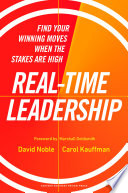

Empowering team members is a central theme in 'Real-Time Leadership.' The book argues that leaders should delegate authority and encourage autonomy among their teams. When individuals feel empowered, they are more likely to take initiative, innovate, and contribute to the organization's goals. The authors suggest that leaders should provide clear expectations and the necessary resources while allowing team members the freedom to explore solutions. This approach not only boosts morale but also fosters a sense of ownership and accountability. Empowerment also leads to a more engaged workforce, which is essential for navigating the complexities of today's business environment.
Continue readingIn today's fast-paced world, leaders must learn to embrace uncertainty rather than shying away from it. This idea emphasizes that uncertainty is a fundamental aspect of modern leadership. Leaders are often faced with unpredictable situations, whether due to technological disruptions, market fluctuations, or global events. Embracing uncertainty involves cultivating a mindset that is open to change and adaptable to new circumstances. It requires leaders to develop resilience and the ability to pivot quickly when faced with challenges. By fostering a culture of agility within their teams, leaders can encourage innovation and creative problem-solving, allowing their organizations to thrive even in volatile environments.
Continue readingReal-time decision making is a critical skill for leaders in the current landscape. The book highlights the importance of making informed decisions swiftly, leveraging data and insights available at the moment. Leaders must be equipped to analyze information quickly and act decisively, often with incomplete data. This requires a balance between intuition and analytical thinking. The authors advocate for the use of technology and collaborative tools that facilitate real-time communication and information sharing among team members. By fostering an environment where feedback is immediate and decisions can be adjusted on the fly, organizations can enhance their responsiveness and effectiveness.
Continue readingA learning culture is vital for organizations aiming to remain competitive. The book emphasizes that leaders should prioritize continuous learning and development within their teams. This involves creating an environment where experimentation is encouraged, and failures are seen as opportunities for growth. Leaders can implement training programs, mentorship initiatives, and knowledge-sharing platforms to facilitate learning. By investing in their team's skills and knowledge, organizations can adapt to changes more effectively and drive innovation. A culture of learning also helps attract and retain top talent, as employees are more likely to remain engaged in an environment that values personal and professional growth.
Continue readingTrust and strong relationships are foundational to effective leadership. The authors argue that leaders must prioritize building trust with their teams and stakeholders. This involves being transparent, communicating openly, and demonstrating integrity in all actions. Building relationships also means understanding the individual strengths and weaknesses of team members, which allows leaders to leverage their skills effectively. The book provides strategies for fostering trust, such as regular check-ins, feedback loops, and team-building activities. When trust is established, teams are more cohesive and collaborative, leading to better performance and outcomes.
Continue readingIn the digital age, technology plays a crucial role in facilitating collaboration among teams. The book discusses how leaders can leverage various tools and platforms to enhance communication and teamwork. By utilizing project management software, communication apps, and data-sharing platforms, leaders can ensure that their teams remain connected and aligned, regardless of geographical barriers. The authors emphasize the importance of choosing the right tools that fit the team's needs and promoting their effective use. Technology can also provide valuable insights through data analytics, enabling leaders to make informed decisions and track progress in real-time.
Continue readingThe final key idea is the importance of focusing on outcomes rather than rigid processes. The authors argue that while processes are essential for organization, an overemphasis on them can stifle creativity and adaptability. Leaders should define clear goals and desired outcomes, allowing teams the flexibility to determine how to achieve them. This approach encourages innovation and empowers team members to think critically about their work. By fostering an outcome-oriented mindset, organizations can remain agile and responsive to changing circumstances, ultimately leading to better results and greater success.
Continue reading